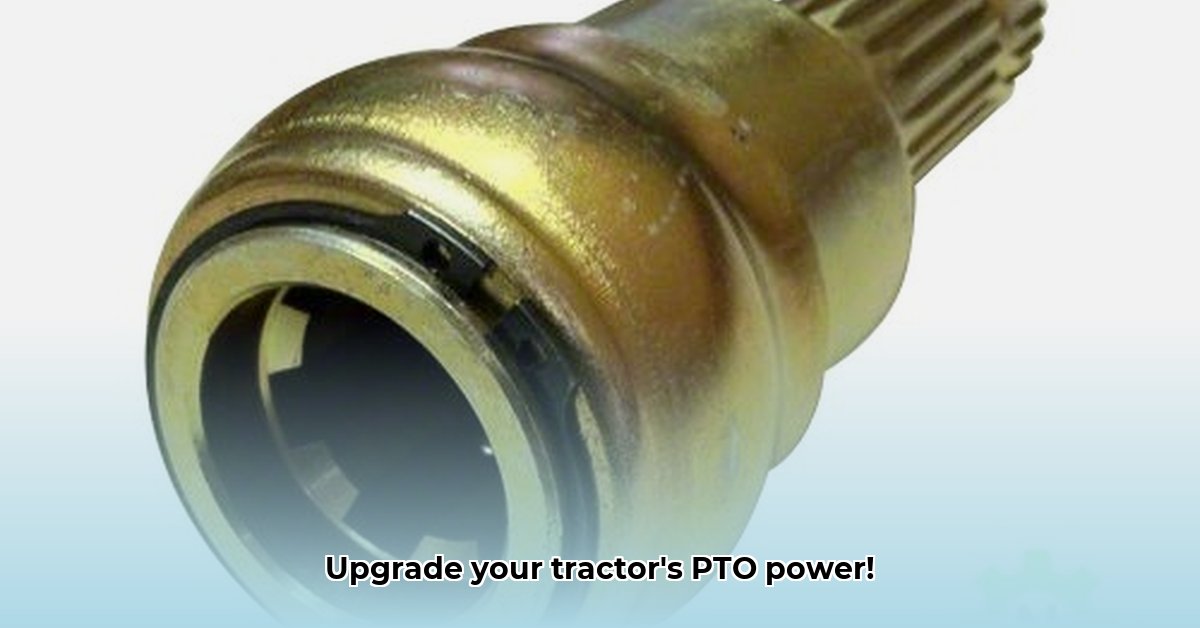
Understanding the 540 to 1000 PTO Adapter and its Role in Sustainable Agriculture
A 540 to 1000 PTO adapter, readily available at Tractor Supply Company, is a crucial tool for modern sustainable farming. This simple device bridges the gap between tractors with a 540 RPM (revolutions per minute) power take-off (PTO) shaft and implements designed for the faster 1000 RPM speed. This compatibility is key to maximizing equipment lifespan, optimizing tasks, and reducing reliance on specialized, often more fuel-intensive machinery—a core tenet of environmentally responsible farming. By extending the life of existing equipment, farmers can significantly reduce waste and their environmental impact. For more information on PTO adapters, check out this helpful resource.
Technical Specifications and Compatibility: Ensuring a Secure and Efficient Connection
Before installation, careful consideration of the adapter's specifications is paramount. These details, readily available from Tractor Supply, will ensure compatibility and safety.
Dimensions and Weight: Dimensions and weight vary by model. Always consult the product specifications before purchase to ensure suitability for your tractor and intended implements.
Material Composition and Durability: Most adapters are constructed from high-strength steel alloys for superior durability and longevity. Look for models incorporating recycled materials, further enhancing their sustainability credentials.
Compatibility with Tractors and Implements: Precise compatibility is crucial. Verify that the adapter's shaft size (e.g., 1 3/8" x 6 spline, 1" x 8 spline) matches both your tractor's PTO output and the input requirements of your implements. Improper matching can lead to significant damage. Consult both your tractor's manual and the implement's specifications for precise compatibility details.
Installation Instructions: Detailed installation instructions are provided with each adapter. Always follow these instructions meticulously. A secure connection is critical for safety and operational efficiency. Common steps include aligning the input and output shafts, ensuring a tight and secure connection using the provided fastening mechanisms, and double-checking all connections before operation.
Safety Precautions: Working with PTO shafts necessitates strict adherence to safety protocols. Always ensure the tractor is securely parked, the engine is off, and the PTO is disengaged before installing or servicing the adapter.
Practical Applications in Sustainable Agriculture: Optimizing Efficiency and Minimizing Waste
The 540 to 1000 PTO adapter offers several compelling benefits within the context of sustainable agriculture:
Increased Implement Versatility: The adapter allows use of a broader range of implements with a single tractor, avoiding the need to purchase additional specialized equipment. This reduces both capital expenditure and material waste associated with manufacturing additional machinery.
Optimized Task Performance: Matching implement speed to the task improves efficiency, enhancing overall productivity. This can dramatically reduce fuel consumption and operating time.
Extended Equipment Lifespan: By maximizing the utilization of existing equipment, the adapter significantly extends its operational life, deferring the need for replacement and reducing waste associated with premature disposal.
Precision Agriculture Integration (where applicable): The adapter's ability to seamlessly integrate with various implements can facilitate compatibility with precision agriculture technologies, further enhancing operational efficiency and minimizing resource use.
Responsible Disposal: At the end of its lifespan, responsible disposal or recycling of the adapter helps to minimize environmental impact. Check with local recycling centers for appropriate disposal methods.
Maintenance and Troubleshooting: Ensuring Long-Term Performance and Sustainability
Regular maintenance is essential for the adapter's long-term performance and to ensure its sustainable use.
Regular Inspections: Periodically inspect the adapter for any signs of wear, loose components, or damage. Prompt attention to minor issues prevents them from escalating into major problems.
Lubrication: Regular lubrication of moving parts, according to the manufacturer's instructions, is crucial for smooth operation and extended lifespan.
Troubleshooting Common Issues: Minor issues, such as unusual vibrations or binding, can often be addressed through simple adjustments or cleaning. Refer to the adapter's manual for detailed troubleshooting guidance. However, significant issues should warrant professional assessment and repair.
Cost-Benefit Analysis within a Sustainability Framework: Building Long-Term Value
While the initial investment in a 540 to 1000 PTO adapter is modest, the long-term cost savings and environmental benefits are substantial.
Reduced Equipment Costs: The increased versatility minimizes the need to purchase additional specialized implements, leading to significant long-term cost savings.
Enhanced Efficiency and Productivity: Optimized implement speed results in improved performance and faster task completion, directly translating into increased efficiency and productivity.
Minimized Environmental Impact: Reduced fuel consumption, extended equipment lifespan, and decreased reliance on new equipment dramatically reduce the overall environmental footprint of farming operations.
Conclusion: A Sustainable Investment for Modern Farming
The 540 to 1000 PTO adapter represents a significant advancement in sustainable agricultural practices. By enhancing equipment versatility, optimizing operational efficiency, and minimizing environmental impact, this simple yet powerful device offers farmers a compelling pathway towards a more sustainable and economically viable future. The relatively small initial investment yields significant long-term returns, making it a worthwhile addition to any farm committed to sustainable and environmentally responsible practices.